
* The Vietnam war saw the first serious use of helicopters in direct combat. The Bell UH-1 "Huey" transport helicopter was fitted with armament to shoot it out with Viet Cong insurgents, but the Huey was not really designed for such a mission. However, Bell had been working on a dedicated gunship, the "AH-1", derived from the Huey, and the US Army and Marines put it into service in the conflict, where the "Cobra" fought with distinction.
The Army's long-range goal was on an antitank helicopter, the Cobra having been selected simply as an interim type, and Bell came up with two proposals for the requirement: an enhanced AH-1, the "Model 309 KingCobra", and the generally new-design "Model 409". Neither would be selected for production, but the KingCobra would have an influence on the future evolution of the AH-1.
* As the United States Army ramped up its involvement in Vietnam in the early 1960s, Bell's UH-1 "Iroquois" AKA "Huey" turbine-powered helicopter, first flown in 1956, became the workhorse of Army heliborne combat operations. When the "UH-1A" was deployed to Southeast Asia in 1962, it was the Army's first armed helicopter to see real combat. The UH-1A was followed by the bigger and more powerful "UH-1B" and the still more powerful "UH-1C", but combat experience demonstrated that the Huey left something to be desired in the helicopter gunship role. Something faster and less vulnerable was needed.
The Bell company had been interested in the concept of a dedicated helicopter gunship since 1958, and unveiled a mockup of such a machine in June 1962. The "D225 Iroquois Warrior" was based on the engine and mechanics of the Huey, but had a new sharklike fuselage that gave it the looks of a fighter. It had a tandem two-seat cockpit with a gunner in front and a pilot in back, with the seats stepped to give the pilot good forward visibility; a turret with an automatic grenade launcher in the nose; a forward-firing 20-millimeter cannon in a belly pack; and stub wings with stores pylons to carry munitions, such as six SS-11 wire-guided missiles.
The Army liked the idea and awarded Bell a contract in December 1962 to develop a proof-of-concept demonstrator. Bell engineers quickly modified the company's well-established Model 47 / OH-13 Sioux piston-powered helicopter to produce the "Model 207 Sioux Scout", which was completed in August 1963. The Sioux Scout featured a streamlined fuselage, with a tandem cockpit and a chin turret with two 7.62-millimeter M60 machine guns. It only generally resembled the Iroquois Warrior mockup, and was obviously too light for serious combat use. It was strictly a demonstrator -- but though it was something of a "toy" gunship and looked like it, it allowed the Army to explore the possibilities of such a weapon.
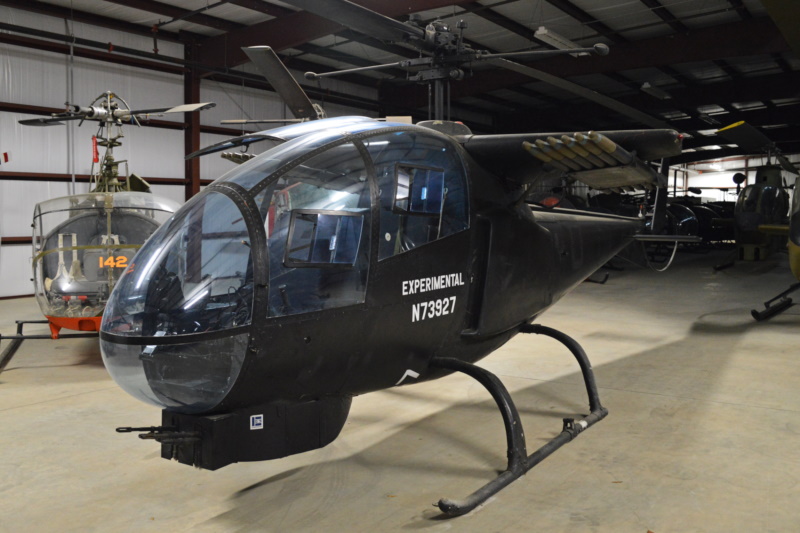
* The Army decided to obtain an operational gunship -- beginning an investigation into a "Fire-support Aerial System (FAS)", which led to the issue of requirements for a formidable "Advanced Aerial Fire Support System (AAFSS)" competition in August 1964. Several companies submitted proposals, with the Army selecting the Lockheed AH-56 "Cheyenne" for development.
The Cheyenne wasn't scheduled to be available until 1970. The pressures of the Vietnam War meant the Army needed a gunship helicopter right away, and so in 1965 the service initiated a competition for an "interim" gunship, based on an existing helicopter type, that could be put into combat as quickly as possible. The Army received proposals for a modified Chinook from Boeing-Vertol; a modified Sea King from Sikorsky; a modified Sea Sprite from Kaman; and a "modified UH-1" from Bell designated the Model 209.
Although Bell had been eliminated from the AAFSS competition early on, the company had continued to work on a dedicated helicopter gunship using company funds. Calling the Model 209 a "modified UH-1" was a big stretch, since it could not possibly be mistaken for a Huey, though it shared many systems and parts. Bell was able to convince Army officials that the Model 209 could be available when they wanted it, and so the Army accepted the fiction.
The Model 209 demonstrator strongly resembled the D225 Iroquois Warrior, featuring a sharklike fuselage, tandem seats, and stub wings. It was powered by an Avco Lycoming T53-L-11 turboshaft engine generating 820 kW (1,100 SHP). Up to that time, Bell helicopters had used a two-bladed rotor with a crosswise stabilizing bar, but to save weight the stabilizing bar was eliminated by an electromechanical "Stability Control Augmentation System (SCAS)". The engine and rotor system were taken directly from the UH-1C Huey, and in fact the entire tail boom was a UH-1C assembly.
The Model 209 featured an Emerson Electric chin turret with a General Electric (GE) 7.62-millimeter GAU-2B/A six-barreled Gatling "Minigun". The stubby wings were fitted with a total of four stores pylons, which could carry unguided missile packs, gun pods, or other stores. The Model 209 had retractable skid undercarriage, which appears to have been adopted at least as much to improve the turret's field of fire and ensure clean stores release as to improve aerodynamics. Forward fuselage panels were flush-riveted and antennas were fitted internally to keep the airframe as clean as possible.
* Bell proposed the Model 209 to the Army in August 1965, and the new helicopter made its first flight a month later, on 7 September 1965. In October, it set a world helicopter speed record for its class of 320 KPH (200 MPH). The Army conducted a flyoff competition for the interim gunship in November 1965. The Model 209 had such a jump on the other submissions that in hindsight its selection was almost obvious, though the Army did experiment with the Chinook gunship in Vietnam. The Army placed a contract with Bell for two prototypes of an operational version of the Model 209 on 7 April 1966, followed by a production contract for 110 of the gunships on 13 April.
The production version of the Model 209 was originally designated "UH-1H", in keeping with the fiction that the gunship was just a "modified UH-1". However, in July 1966, the designation was changed to "AH-1", similar enough to the UH-1 designation to keep up the pretense.
Traditionally, the Army named their aircraft after American native tribes, such as "Mohawk", "Iroquois", "Sioux", "Cheyenne", and so on, but the service was engaged at the time in an odd exercise in litigation with Piper Aircraft, which also used tribal names for their aircraft. This permitted a break with tradition. UH-1 Hueys operating in Vietnam at the time were known as "Slicks" if they were unarmed transports; "Hawgs" if they were armed with rockets; and "Cobras" if they were armed with machine guns and rockets. It was in keeping with the story that the AH-1 was really just a modified Huey to name it the "HueyCobra". In practice, though the name "HueyCobra" would linger in print, in practice AH-1 would become universally known as the "Cobra", with the original use of this name for the UH-1 generally forgotten.
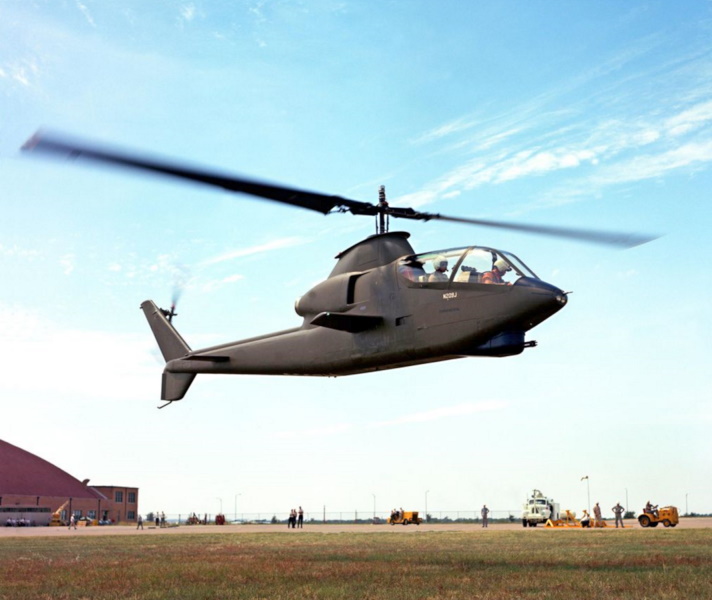
* The Model 209 demonstrator was kept in service for almost six years to test different weapon and equipment fits, ultimately being brought up to something very similar to production AH-1 standard. It was restored to an approximation of its original form when it was retired, to be placed on display at the Patton Museum at Fort Knox, Kentucky. There are also some rumors that a second Model 209 demonstrator was built -- but if so, the details are unclear.
BACK_TO_TOP* The initial production Cobra was given the designation "AH-1G". The first of the two prototypes, sometimes referred to as "YAH-1Gs", flew on 15 October 1966, with the second making its first flight in March 1967.
The AH-1G was very similar to the Model 209, with some minor changes. The AH-1G was fitted with an uprated T53-L-13 turboshaft engine with 1,045 kW (1,400 SHP), and the retractable landing skids were changed to fixed skids, since the benefits of retractable skids weren't substantial enough to outweigh potential reliability problems; few liked the idea of a "wheels up" landing in a helicopter. There were attachment points on the skids to allow wheels to be clipped on for towing the Cobra on a runway. The Model 209 had also been fitted with a small ventral fin at the end of the tail boom for improved directional stability, but flight tests demonstrated that the Cobra was perfectly stable, and so the AH-1G had no ventral fin.
The AH-1G defined the "baseline" configuration for subsequent members of the family. The highly streamlined fuselage was built with honeycomb aluminum, with plenty of access panels for easy maintenance. The AH-1G had a 936-liter (247 US gallon) self-sealing fuel tank, plus armor protection for the engine, fuel systems, and hydraulic systems. The two crew members sat in armored seats with side panels that could be pulled up in a pinch for more protection, and an armored nose plate was fitted to shield the gunner. Although the Model 209 demonstrator had been fitted with armor glass, it was judged too heavy, and no production AH-1 would ever be rolled out with armor glass.
___________________________________________________________________
BELL AH-1G COBRA:
___________________________________________________________________
rotor diameter:
13.4 meters (44 feet)
fuselage length:
13.54 meters (44 feet 5 inches)
footprint length:
16.14 meters (53 feet)
height:
4.09 meters (13 feet 5 inches)
operating weight:
2,765 kilograms (6,095 pounds)
max loaded weight:
4,310 kilograms (9,500 pounds)
cruise speed:
265 KPH (165 MPH / 145 KT)
service ceiling:
4,145 meters (13,600 feet)
hover ceiling (in ground effect):
3,290 meters (10,800 feet)
range:
580 kilometers (360 MI / 315 NMI)
___________________________________________________________________
The AH-1G was originally fitted with the Emerson Electric "TAT-102A" turret with a single GE GAU-2B/A Minigun with 8,000 rounds of ammunition. This was a temporary fit, installed until the improved "TAT-141" turret became available. The TAT-141 was fitted with either two Miniguns with 4,000 rounds each, or a single Minigun and an M129 40-millimeter grenade launcher with 300 (some sources say 231) rounds of ammunition. Apparently the TAT-141 could in principle also be fitted with two grenade launchers, but this was rarely if ever done.
The Minigun could be selected for rates of fire of 2,000 or 4,000 rounds per minute (RPM), while the grenade launcher had a rate of fire of 450 RPM. The turret could be aimed 25 degrees upward, 60 degrees downward, and over 230 degrees of arc. Although the gunner normally operated the turret, the pilot could fire it in the fixed-forward position in an emergency. The gunner also had simple flight controls to allow him to fly the machine in an emergency.
* The AH-1G arrived at Bien Hoa Air Force Base in South Vietnam in August 1967, and found itself in the thick of combat immediately. Cobras were used to escort transport helicopter forces and provide fire support for ground operations. They were also used in conjunction with fast Hughes OH-6A Cayuse "Loach" scout helicopters in devastatingly effective "hunter-killer" AKA "Pink" teams. Cobras were also used in other roles when required, including armed reconnaissance, target spotting, and even search and rescue. By the end of 1968, there were 337 Cobras in Vietnam.
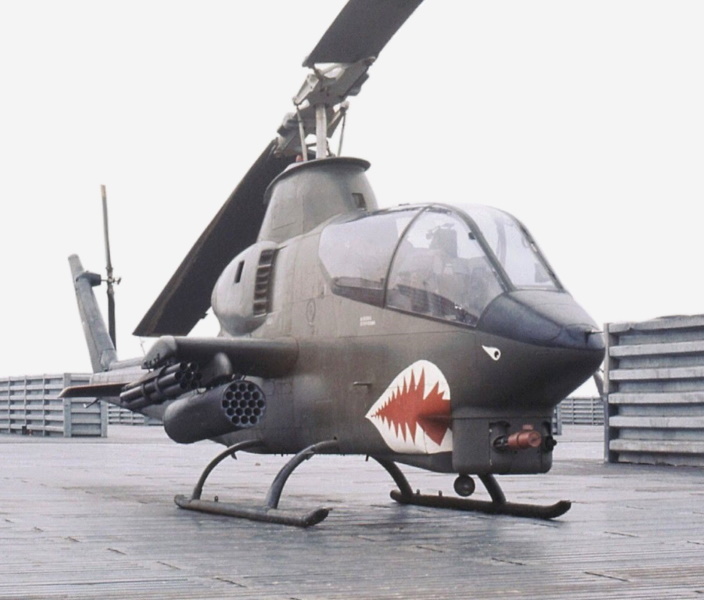
While many gunship crews liked the speed, agility, and hard-to-hit slender lines of the Cobra, there was another faction that preferred the old Huey gunships: the door gunners not only provided additional eyes and ears, they could also lay down suppressive fire to the rear of the helicopter. The debate between the two factions went on through the war.
The Cobra's primary external warloads were 7-round or 19-round 70-millimeter (2.75-inch) rocket pods, with rockets fitted with high explosive warheads; anti-personnel flechette / dart ("nail") warheads; white phosphorus incendiary warheads; or smoke target marking warheads. Four-round 127-millimeter (5-inch) Zuni rocket pods were also qualified, but rarely if ever used in combat. The rocket pods were called "Hog pods"; a Cobra with a full load of four Hog pods was called a "Heavy Hog".
Early Cobras with the one-gun turret also sometimes carried one or two SUU-11/A Minigun pods with 1,500 rounds each on the stub wing pylons. The range and killing power of the Minigun was limited, however, and though the 70-millimeter rockets had much more reach and punch, they were inaccurate and had to generally be fired in salvos to blanket a target. To provide more hitting power, beginning in 1969 many AH-1Gs were fitted with the XM-35 cannon system, which was a GE M61A1 Vulcan 20-millimeter six-barrel Gatling gun carried on a pylon, with a streamlined fairing attached to the left side of the helicopter on the top of the landing skid for ammunition storage, and panels added below the cockpit to provide protection from muzzle blast. Aircrews had to hang on to canopy panels when firing to keep the panels from popping open.
* The AH-1G underwent a number of changes during its service in Vietnam. Early production AH-1Gs had landing lights built into the tip of the nose. Later production moved the landing lights into a retractable fixture in front of the turret.
The Cobra's big canopy made for a pretty good greenhouse, turning the cockpit into a "hotbox". While the AH-1G was originally delivered with ventilation blowers to keep the flightcrew comfortable, the blowers were totally inadequate for service in Vietnam; a much more effective air-conditioning system AKA "environmental control unit (ECU)" was installed in the field and in later production.
One of the more significant changes was the switch of the tail rotor from the left to the right side of the helicopter. This was done to improve directional control. Retrofits were made in the field by swapping out the entire tail boom with a replacement unit.
Very late in the war, during the North Vietnamese spring offensive of 1972, two Cobras were shot down by enemy SA-7 shoulder-launched surface-to-air missiles (SAM), some Cobras were fitted with an upturned "sugar bowl" exhaust to reduce their infrared profile, with some minor detriment to performance, also being kitted up with an AN/ALQ-144 infrared countermeasures (IRCM) unit on the engine cowling just forward of the exhaust.
The AN/ALQ-44 was what is known as "hot brick" or "disco light" jammer. It was a little cylindrical "lighthouse" faced with a hot ceramic brick core that radiated strongly in the infrared. The core was surrounded by a rotating shutter that turned the infrared output on and off. A heatseeking SAM tried to home in on the hot jammer module, but when it was pulsed "off", the missile then assumed it had lost lock and veered off target.
* The AH-1G Cobra was basically a daylight weapon, though it could be used at night in a pinch when supported with illumination flares and searchlights. The Army performed two experiments to develop a night-capable Cobra.
The first was the "Southeast Asia Multi-Sensor Armament Subsystem for HueyCobra (SMASH)" program. SMASH featured an AH-1G fitted in the nose with an Aerojet ElectroSystems AN/AAQ-5 "Sighting System Passive Infra-red (SSPI)" sensor turret, basically what would later be called a "forward looking infrared (FLIR)" imager; and an Emerson Electric AN/APQ-137B "moving target indicator (MTI)" radar pod carried under the right wing. Incidentally, the SMASH experiment was conducted under the umbrella of the "Expedite Non-Standard Urgent Requirement for Equipment (ENSURE)" program; the military was into "cutesy acronyms" in those days.
The second experiment was the "Cobra Night Fire Control System (CONFIGS)", which was fitted in the nose with a low-light TV (LLTV) imager. The imager resembled a length of pipe bent into a "U" shape, and gave the Cobra a peculiar look of having a "mustache". The CONFIGS imager could rotate to track turret movements. These sensor technologies were new and immature in the Vietnam era, and neither SMASH nor CONFIGS were successful. However, the idea of a night-capable Cobra would be back.
A total of 1,116 AH-1Gs was ultimately built, with the last delivered in February 1973. About 300 were lost in Vietnam, with about a third of these destroyed in non-combat-related accidents. Precise numbers of losses are difficult to tally, because in some cases the Cobras were recovered and rebuilt by enterprising ground crew teams. No doubt there were some "hybrids" in which one helicopter was put together from the wreckage of two or more -- ground crews might have well just done it for the fun of it in some cases.
* An Army AH-1G was provided to the US National Aeronautics & Space Administration's (NASA) Langley Flight Center, where it was painted in a spiffy NASA white color scheme with blue detailing and used for various experiments in such areas as noise reduction. It was later passed on to the NASA Ames Flight Center, where it mostly served as a chase machine, and was finally returned to the US Army, where it was updated to the improved "AH-1S", discussed in the next chapter.
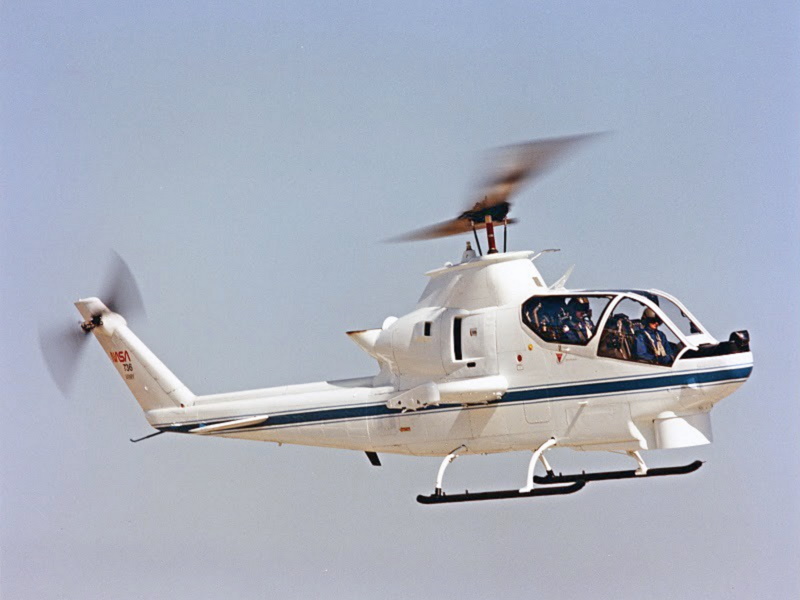
The US Customs Service obtained a handful of AH-1Gs to help hunt down drugrunners in fast boats and light aircraft. These helicopters were unarmed, featuring a searchlight instead of weapons in the nose turret, and were referred to as "Snakes".
BACK_TO_TOP* The US Marine Corps was very interested in the Cobra, but preferred a twin-engined version for improved safety in over-water operations, and also wanted a more potent turret-mounted weapon. Although at first the Department of Defense had balked at providing the Marines with a twin-engined version of the Cobra, in the belief that commonality with Army AH-1Gs outweighed the advantages of a different engine fit, the Marines won out, and awarded Bell a contract for 49 twin-engined AH-1J "SeaCobras" in May 1968. As an interim measure, the US Army passed on 38 AH-1Gs to the Marines in 1969.
The first AH-1J made its initial flight in November 1969. The most prominent features of the SeaCobra were its Pratt & Whitney Canada (P&WC) T400-CP-400 Twin Pac engine system, and its GE M197 20-millimeter cannon mounted in a "universal turret".
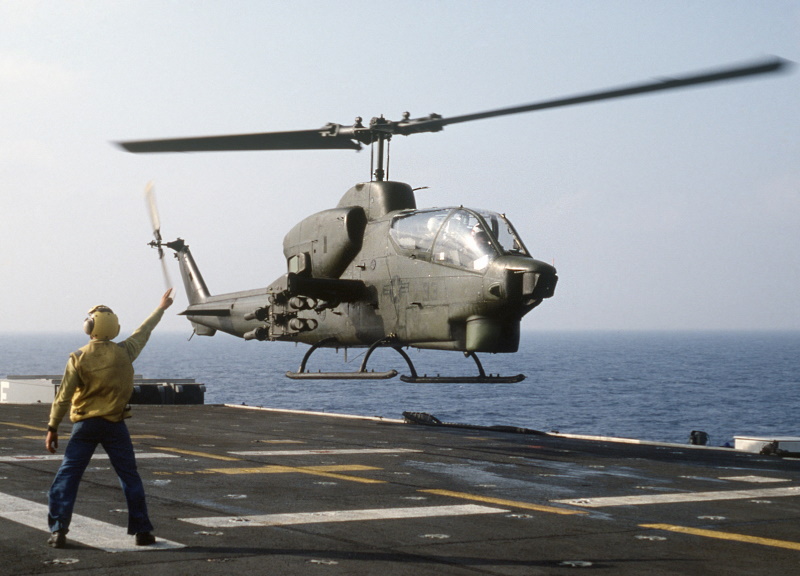
The Twin Pac engine system had only recently been developed by a joint US-Canadian program for what would eventually emerge as the Model 212 Twin Huey, and it was available just in time to give the Marines a twin-engine Cobra. The T400-CP-400 engine system was basically two P&WC PT6 turboshafts driving a common gearbox, and in fact was also known as the "PT6T-4". Total output power of the engine system was 1,140 kW (1,530 SHP), a comfortable boost upward from the 1,045 kW (1,400 SHP) of the AH-1G's Lycoming T53-L-13 engine. The Twin Pac provided enough power to keep the helicopter flying with an engine out. The Twin Pac engine system was actually capable of providing 1,340 kW (1,800 SHP), but the helicopter's drive train wasn't robust enough to support it. When both engines were running, they were power-limited; when one engine went out, the other could be run at full power.
The M197 was essentially a three-barrel version of the six-barrel Vulcan cannon, and would eventually become the standard turret weapon for both Marine and Army Cobras. The M197 had a rate of fire of 750 rounds per minute, though it could only fire 16-round bursts; the AH-1J carried an ammunition supply of 750 rounds. The gun could be aimed 20.5 degrees upward, 50 degrees downward, and over 240 degrees of arc. The AH-1J also had a slightly larger fuel tank, with a capacity of 1,023 liters (270 US gallons) instead of 936 liters (247 US gallons), and had a number of minor equipment fits to tailor it for USMC service.
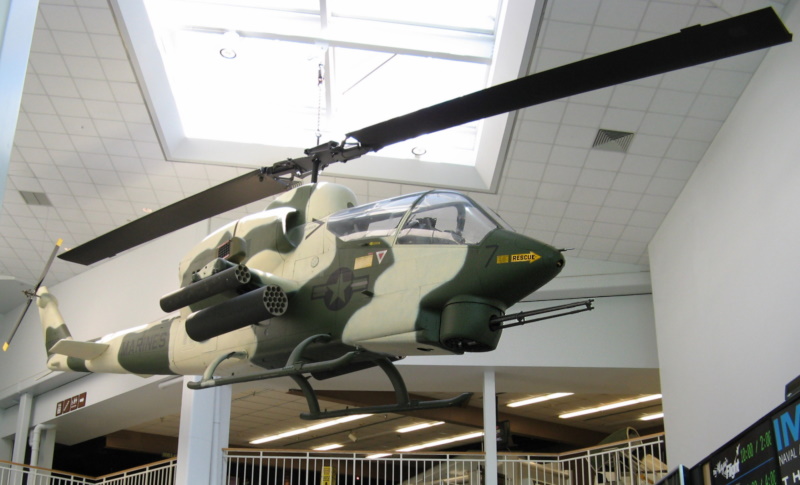
Initial delivery of the AH-1J was in October 1969, with the type beginning service evaluation in July 1970. Four AH-1Js were sent to South Vietnam in February 1971 for a two-month combat evaluation. They participated in the South Vietnamese invasion of Laos, which lasted until April. These SeaCobras were then withdrawn, but AH-1Js were re-deployed to the theater from Okinawa during the North Vietnamese offensive of 1972.
The Marines bought a second batch of AH-1Js, bringing total procurement to 69, with the last rolled out in February 1975. The AH-1J and later twin-engine Cobra variants were sometimes referred to as "TwinCobras".
BACK_TO_TOP* The AH-1G had been purchased by the US Army as an "interim type" for the "jungle fighting" role, but the Army's broader concern was the task of protecting Western Europe from the legions of Warsaw Pact armor to the east.
The Army had initiated the AAFSS program to develop the Lockheed AH-56 Cheyenne for the anti-tank gunship role, but development of the Cheyenne did not go smoothly, and as one writer put it, "the vultures began to gather", with Sikorsky and Bell trying to sell unsolicited alternatives to the Army. The Sikorsky offering was the "S-67 Blackhawk", a sleek gunship, which despite the name had no real relationship to the later S-70 Black Hawk utility-transport helicopter. The Bell offering was a refined Cobra, the "Model 309 KingCobra".
Bell announced the KingCobra program in January 1971. Two prototypes were built, one with a P&WC T400-CP-400 Twin Pac dual turboshaft engine system much like that used on the AH-1J, but with a stronger drive train permitting full 1,340 kW (1,800 SHP) operation, and the other with a single Lycoming T55-L-7C turboshaft engine with 1,490 kW (2,000 SHP).
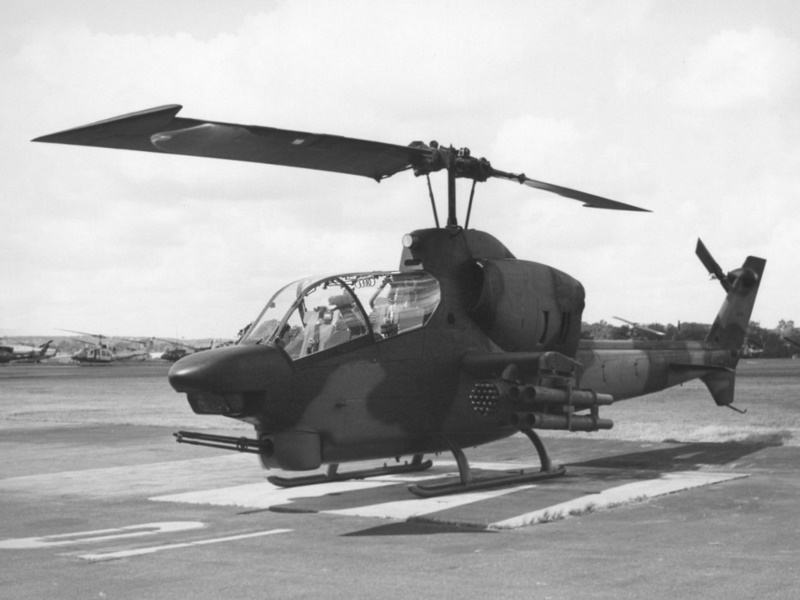
The Twin KingCobra first flew on 10 September 1971. It looked much like an AH-1J, except for a longer and distinctive "buzzard beak" nose and a ventral fin like that on the original Model 209 demonstrator. However, there were significant changes that were less noticeable:
The primary weapon of the KingCobra was to be the new Hughes "BGM-71 TOW" anti-tank missile -- the name standing for "Tube-launched, Optically tracked, Wire-guided" -- which had proven highly effective in combat test firings in Vietnam from Huey gunships. This weapon could be carried in a pack of four missiles, with one pack under each stub wing for a total of eight missiles. On launch, the TOW trailed out wires for receiving command guidance updates. The missile had two infrared flares on its tail to allow the SMS to track it. All the gunner had to do was keep the target in his sight, and the missile fire control system adjusted its flight appropriately. Both the gunner and the pilot had Sperry Univac helmet-mounted sights to allow them to acquire targets for the KingCobra's missiles and gun.
A "big wing", with a span of 4 meters (13 feet), was designed for the KingCobra, but apparently never fitted except as a static mockup. The "big wing" was to provide additional fuel and stores carriage capability.
* The single-engine KingCobra first flew in January 1972. Other than engine fit, it was almost identical to the twin-engine KingCobra. The Army began an evaluation of the KingCobra and the Sikorsky S-67 that spring, to see how they stacked up against the AH-56. The single-engine KingCobra prototype was wrecked in an accident in April and to complete the Army evaluation, the twin-engine KingCobra was modified to the single-engine configuration. The evaluation was completed in July 1972 -- the result being that the Army decided to give up on the AH-56A program and start all over again, initiating a new "Advanced Attack Helicopter (AAH)" program. The KingCobra and Sikorsky S-67 effectively died.
The Army specified that the AAH was to be powered by twin General Electric T700 turboshaft engines with 1,120 kW (1,500 SHP) each, the same powerplant fit specified for a new Army utility helicopter competition that would be won by the Sikorsky S-70 Black Hawk. The AAH would be armed with a 30-millimeter cannon and sixteen TOW anti-tank missiles. The missile armament specification was later modified to include an alternate load of 16 laser-guided "AGM-114 Hellfire" anti-tank missiles. Hellfire was then in development and promised greater range and lethality than TOW.
Boeing-Vertol, Bell, Hughes, Lockheed, and Sikorsky all submitted proposals for the AAH program. In June 1973, Bell and Hughes were selected as finalists, and were each awarded contracts for the construction of two prototype aircraft. The Bell entry, the "Model 409" or "YAH-63", was by no means "just another Cobra design", though it leveraged off Cobra technology where possible. Although it had what had become by then the typical configuration for a helicopter gunship, with a sharklike fuselage, tandem crew seating, and stub wings for armament, the YAH-63 was largely a new machine.
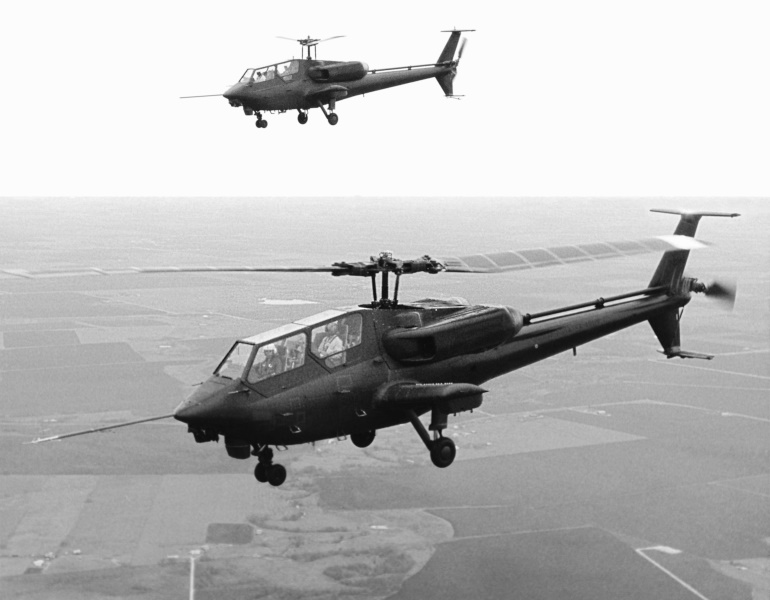
Distinctive features included wheeled tricycle landing gear; flat canopy window plates; an unusual "tee" tail; a large ventral fin; and a three-barreled GE XM-188 30-millimeter cannon. One less noticeable feature was that the pilot occupied the front seat instead of the back, the reverse of the AH-1's arrangement. That was felt to be more prudent since the YAH-63 was intended to fly "in the treetops", or what is more formally called "nap of earth (NOE)" operations, and the pilot needed to have a clear view of the surroundings.
The first prototype of the YAH-63 made its initial flight on 1 October 1975. This machine crashed in June 1976, but a static test prototype was brought up to flight standard and, along with the second prototype, entered the flyoff against the Hughes entry, the "Model 77" or "YAH-64".
The YAH-64 was selected the winner in December 1976, and entered service as the "AH-64 Apache". The Army felt the YAH-63's two-blade rotor was more vulnerable to damage than the Apache's four-bladed rotor, and the service didn't like the YAH-63's tricycle landing gear scheme, feeling it was less stable than the Apache's tailwheel configuration. Some observers also suspected the Army didn't want to divert Bell from AH-1 production.
BACK_TO_TOP